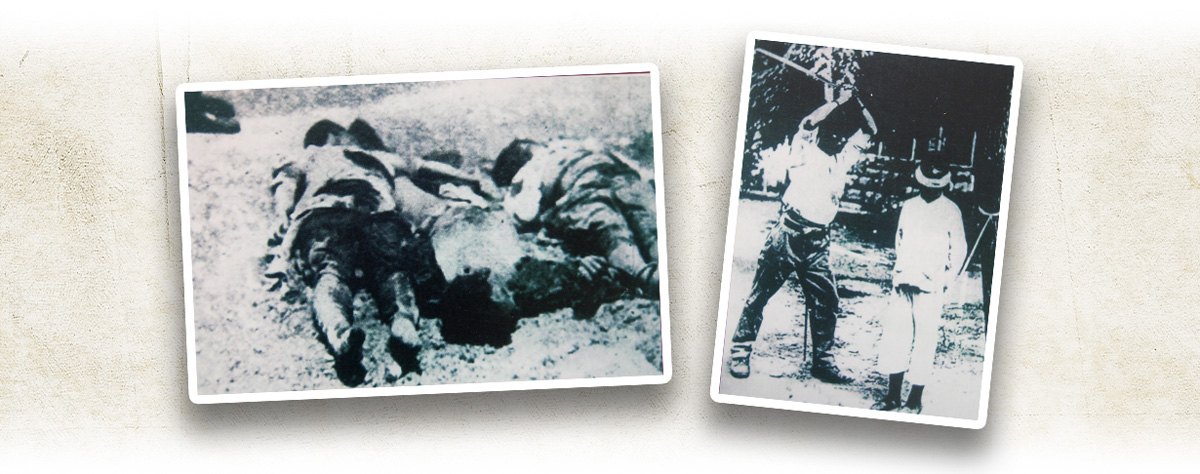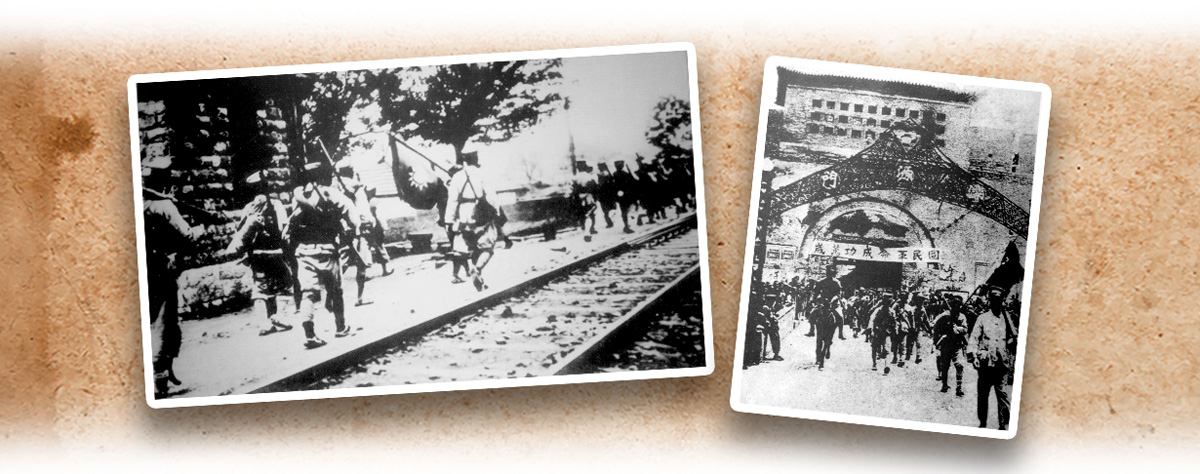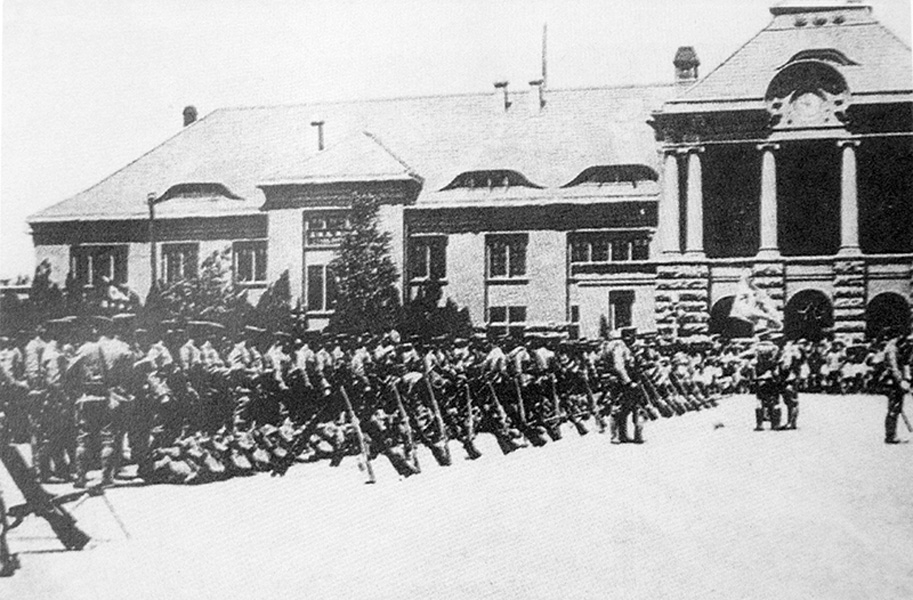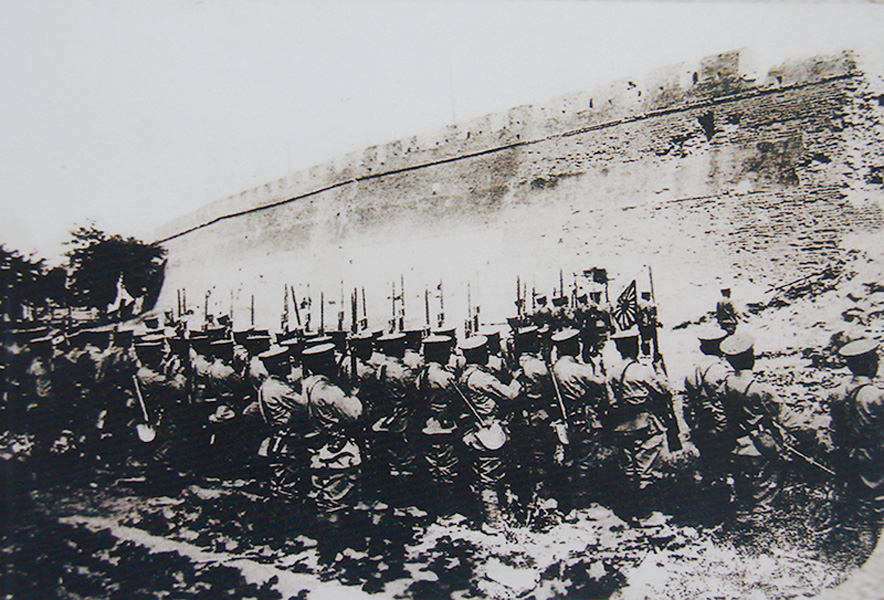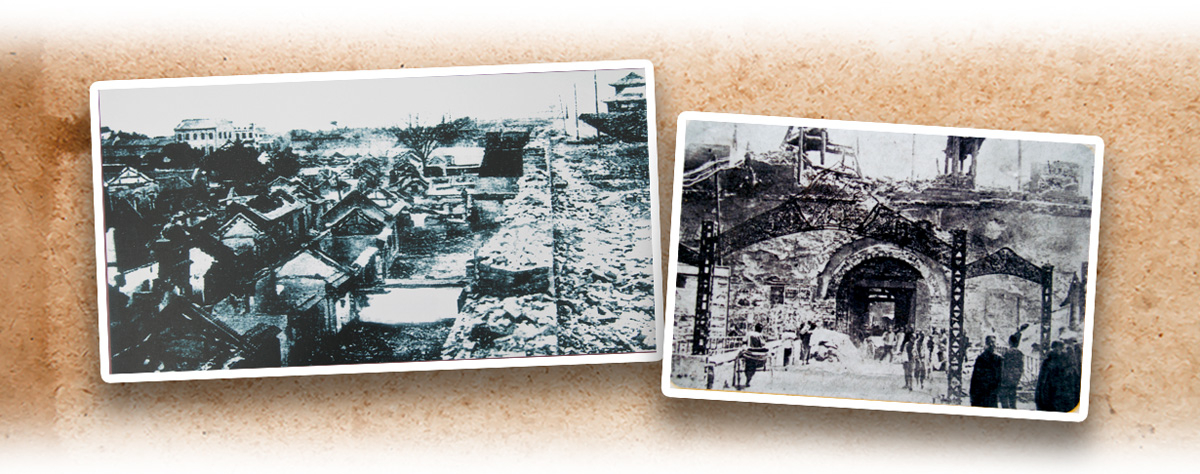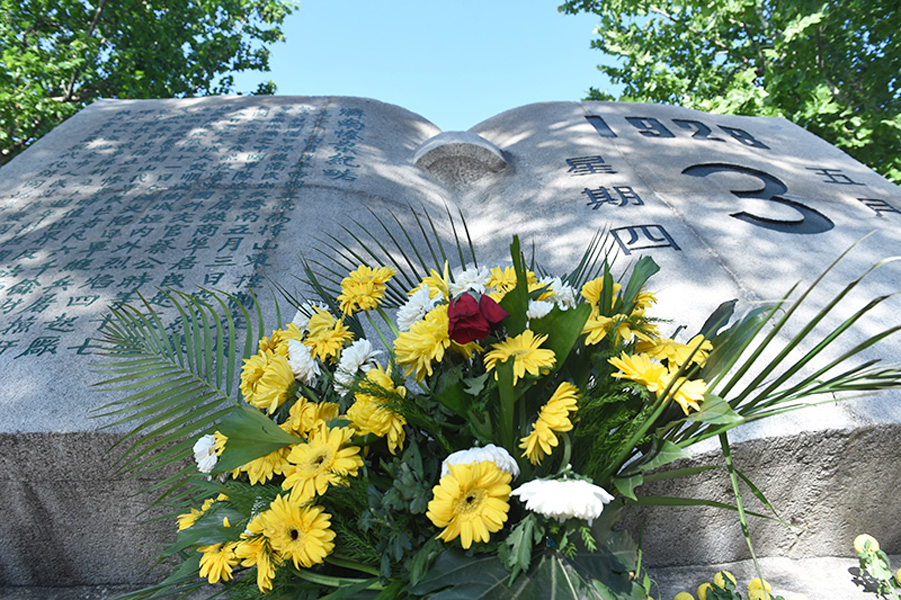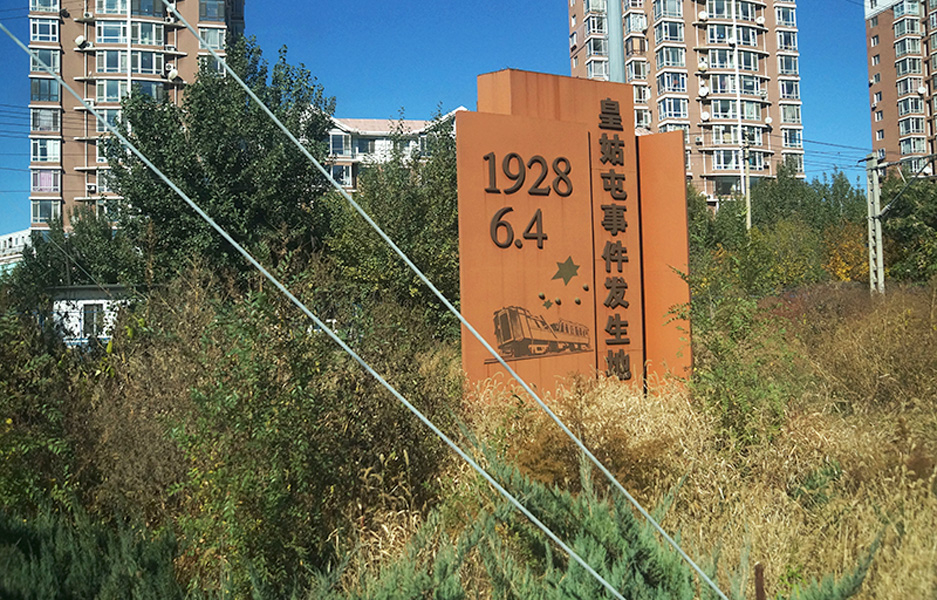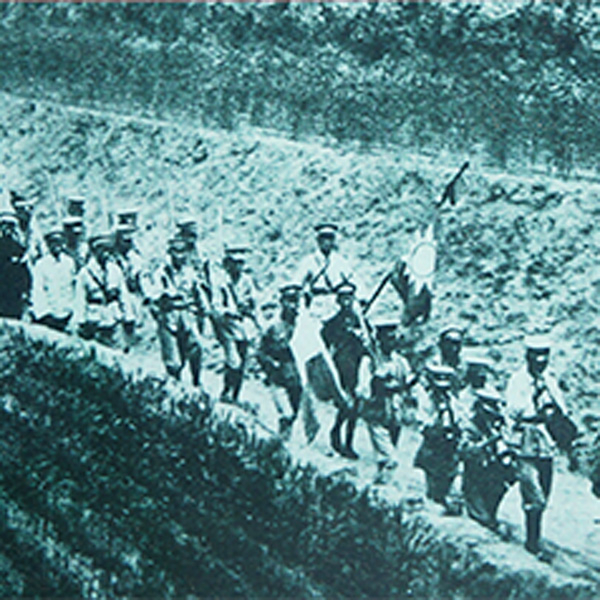Japan’s policy of aggression against China did not change even after the Republic of China was established. Despite the May Fourth Movement and the 1921-22 Washington Naval Conference, Japan still regarded Northeast China and the neighbouring Shandong Province (山東) as its exclusive domain in the aggression against China after withdrawing from Shandong. As the National Revolutionary Army (NRA) won successively, Japan felt China’s reunification would be to its disadvantage and spared no effort to obstruct further victories.
In 1928, the Nationalist Government in Nanjing (南京) resumed the Northern Expedition and the NRA recovered Ji’nan (濟南) on 1 May 1928. At that time, Japan had again dispatched troops to Shandong. In what later known as the May Third (Ji’nan) Incident, the Japanese troops attacked the NRA’s base and invaded the Office of the Commissioner under the Foreign Ministry in Shandong, killing the special commissioner Cai Gongshi (蔡公時) and other staff members. They went on to burn, plunder, and slaughter in Ji’nan. On 11 May, the Japanese troops occupied Ji’nan. The incident caused more than 10,000 casualties of soldiers and civilians. Although Chiang Kai-shek (蔣介石) tried to negotiate and protested, he still insisted on bypassing Ji’nan and continue the Northern Expedition to advance on Hebei Province (河北).
Japan found it impossible to stop the NRA from pushing northward. Therefore, it changed its policy of aggression against China into taking armed control of Northeast China. As a result, the Fengtian clique (奉系) warlord Zhang Zuolin (張作霖) was killed by a bomb planted by the Japanese army in Huanggutun (皇姑屯) near Shenyang (瀋陽), Liaoning Province (遼寧), on his way from Beijing (北京) to Fengtian (奉天) on 4 June 1928. This was known as the Huanggutun Incident.
|
|
The Huanggutun Incident is complicated and confusing. Some sources say that Zhang Zuolin was not bombed by the Japanese army. What happened actually? |
|
|
See answer below. |
After the Nanjing-Wuhan Reconciliation (寧漢合流), the Nanjing Nationalist Government resumed the Northern Expedition in 1928. Left: On 30 April 1928, the NRA got off at Ji’nan Railway Station in Shandong and entered the city. Right: The NRA marching into Ji’nan on 1 May 1928.
The Japanese army lined up on the square of Ji’nan Railway Station on the Jiaoji Railway (or Qingdao-Ji’nan Railway, 膠濟鐵路). The NRA marched into Ji’nan and Japan dispatched troops in the name of protecting its expatriates, intensifying the situation in Ji’nan.
Left: The Japanese army in Ji’nan firing at the NRA. Right: An NRA soldier killed by the Japanese army. On the morning of 3 May 1928, the Japanese army suddenly attacked the NRA. It was a prologue to the May Third Incident (also known as the Ji’nan Incident). The Nationalist Government sent personnel to negotiate with Japan.
Left: A photo of Cai Gongshi, who represented the Nationalist Government in negotiations with the Japanese army. Middle: A painting depicting how Cai was tortured to death. Right: A newspapers reporting on Cai’s martyrdom. On the evening of 3 May 1928, the Japanese army broke into the Office of the Commissioner under the Foreign Ministry in Ji’nan, cut off Cai’s ears and nose, and gouged out his tongue and eyes. Other office staff were shot dead, claiming 17 lives, including Cai.
On 8 May 1928, the Japanese army launched a general offensive on Ji’nan, and occupied the city on 11 May. The picture shows the Japanese army holding a celebration ceremony under the city wall of Ji’nan on 11 May.
During the Ji’nan Incident, the Japanese army violently killed numerous civilians. Left: Civilians killed by the Japanese army lying dead on the roadside. Right: A Japanese soldier raising his sword to slay a boy.
Left: During the Ji’nan Incident, the Japanese army broke into Jiangjiachi Military Hospital (江家池陸軍醫院) and killed all the wounded soldiers and medical staff. Right: The Ji’nan Incident turned more than 20,000 people into refugees.
In addition to causing tens of thousands of Chinese soldiers and civilian casualties, the tragedy also left large part of Ji’nan in ruins.
On the 90th anniversary of the Ji’nan Incident on 3 May 2018, the people of Ji’nan presented flowers in front of the monument in remembrance of the victims.
A sign on the site of the Huanggutun Incident in Shenyang. Not long after the Ji’nan Incident, the Japanese army blew up the train of warlord Zhang Zuolin who dominated Northeast China in Huanggutun on 4 June 1928. Zhang died of serious injuries. It became known as the Huanggutun Incident, and was regarded as Japan’s another obstruction to the Northern Expedition.
During the Ji’nan Incident, the Nationalist Government knew that the NRA was no match for the Japanese army. Therefore, it chose to bear the humiliation to avoid any confrontation and continue the Northern Expedition by making a detour. After losing the battle with the NRA, Zhang Zuolin left Beijing for Northeast China by train on 3 June 1928. When the train passed Huanggutun the next day, a bomb planted by the Japanese army exploded. Zhang died of serious injuries on the same day. It was said that Japan did this to hinder Zhang’s submission to the Nationalist Government. It was also pointed out that Japan intended to shift the blame for the incident to the Nationalist Government and provoke Zhang Xueliang (張學良), the son of Zhang Zuolin, to confront the Nationalist Government. Anyhow, the incident eventually failed to prevent the Northern Expedition from completion.
|
|
The Huanggutun Incident is complicated and confusing. Some sources say that Zhang Zuolin was not bombed by the Japanese army. What happened actually? |
|
|
The Huanggutun Incident refers to the death of Zhang Zuolin in the bomb explosion. The Japanese government once confessed the bombing, and some Japanese war criminals also admitted to the government’s instigation after World War II. However, in the late 1940s, the Japanese government denied its responsibility. For years, many historians believed that Japan always supported Zhang. However, at that time, Zhang was driven by the NRA and Japan was determined to control Northeast China. If Zhang returned to his base in Fengtian, he might not continue to be at the mercy of Japan and even submit to the Nationalist Government. Therefore, Japan decided to eliminate him. It is also said that Japan killed Zhang to frame the Nationalist Government, provoking Zhang Zuolin’s son Zhang Xueliang to confront the Nationalist Government. Recently, however, a Russian historian wrote an article titled Archives of the Death of Marshal Zhang Zuolin, arguing that Zhang was killed by Soviet agents. This has provided a new perspective to this historical event. |
Sources of most photos used in this feature piece: Fotoe (pictures 1-8), Visual China Group (pictures 9 and 10).




